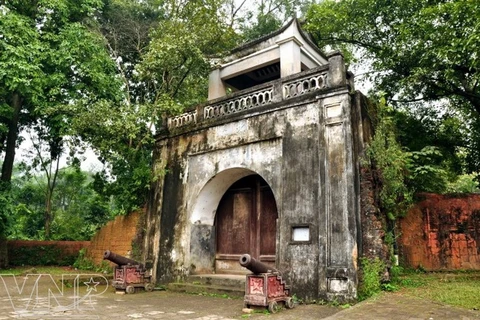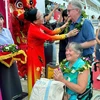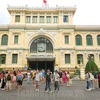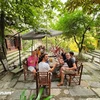 The Son Tay ancient fortress pedestrian zone in the suburbs of Hanoi has been in operation for one year, and is an attractive destination for visitors both in and outside the city. (Photo: VNA)
The Son Tay ancient fortress pedestrian zone in the suburbs of Hanoi has been in operation for one year, and is an attractive destination for visitors both in and outside the city. (Photo: VNA) Hanoi (VNA) – The Son Tay ancient fortress pedestrian zone in the suburbs of Hanoi has been in operation for one year, and is an attractive destination for visitors both in and outside the city.
The zone has lured about 420,000 visitors over the past year, said the People Committee of Son Tay town, noting that the locality has upgraded its infrastructure, and preserved and promoted cultural values of the old fortress.
It is the only suburb in Hanoi that has offered such a night tour, creating a highlight for the entire area, the committee noted.
Nguyen Dang Thao, head of the management board of the Duong Lam ancient village and Son Tay ancient fortress relic sites, said the first phase of the project conserving and promoting values of the old fortress has been completed, giving a facelift to the landscape there.
The town has also paid attention to cultural, art and sport activities in the zone, with more than 350 performances staged over the past time, and various folk games held weekly.
There are also pavilions within the zone introducing products under the “One Commune-One Product” programmes, and local dishes.
Besides, the expansion of the pedestrian space to the Son Tay ancient fortress and surrounding streets has helped boost business activities in such streets as Quang Trung, Nguyen Thai Hoc and Le Loi.
The number of visitors to local tourist sites such as Glory Resort, Thao Viet Resort and Mit Village, and hotels has also increased by 20-30%. During weekends, Glory Resort and Mit Village often have been fully booked and failed to meet tourists’ demand. Notably, the five-star Glory Resort welcomes hundreds of students each day, even thousands in some days, who come to learn about the history and for relaxation.
Chairman of the People’s Committee of Son Tay town Ngo Dinh Ngu said after the one-year pilot of the pedestrian zone, the locality has considered further expanding it to all surrounding streets in order to maximise advantages in terms of location and infrastructure.
 Son Tay is one of the five satellite towns of Hanoi featuring cultural, historical, ecological tourism, commercial services on the basis of preserving traditional cultural heritage. (Photo: VNA)
Son Tay is one of the five satellite towns of Hanoi featuring cultural, historical, ecological tourism, commercial services on the basis of preserving traditional cultural heritage. (Photo: VNA) He cited a survey conducted among local households and tourists as showing that all of them commended the operation of the zone over the past time, and 75% of the questioned residents said they agree with the expansion.
The town also plans to open more night food, entertainment and shopping areas, the official said, adding that it will submit the plan to the municipal People’s Committee for approval when possible.
Son Tay is one of the five satellite towns of Hanoi featuring cultural, historical, ecological tourism, commercial services on the basis of preserving traditional cultural heritage.
Currently there are three pedestrian zones in Hanoi, namely Hoan Kiem Lake, Hanoi’s Old Quarter and Trinh Cong Son street.
The Son Tay ancient fortress citadel, covering 16 ha in Son Tay town, 40km from Hanoi’s centre, not only bears historic value, but also catches attention for its unique architecture.
According to historical documents, Son Tay Citadel was built in 1822 during the reign of Minh Mang Emperor (1791-1841) under the Nguyen Dynasty. It was built entirely of laterite, a material that meets the requirements of a defensive building and was available in the locality.
Following the style of France's Vauban architecture, each side of the square citadel was about 400m long and 5m high. The citadel had four gates facing east, west, south and north, called the Front (Tien), the Back (Hau), the Right (Huu) and the Left (Ta). Each entrance had a guard tower.
Many great events related to the Nguyen’s fight against French colonialism in Vietnamese history took place in the citadel, reflecting its critical significance in guarding the northern plains and midlands and backing the Northwest border./.






















